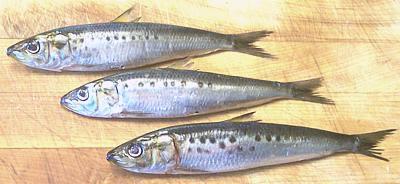 [family Clupeidae (Herrings)]
[family Clupeidae (Herrings)]
There are many varieties of Sardine, all members of the Herring Family, and each variety is likely to be known by a number of local names. Larger fish may be sold fresh but many millions are canned every year, packed in water, oil, mustard sauce and tomato sauce, with and without hot chilis. Morocco is the largest producer of canned sardines in the world, providing 41% of the world's exports. Moroccan sardines tend to have a lot of scales and can range from crumbly to mushy - but I've had some very good ones under the Bandi label, so it isn't all bad
More on the Herring Family
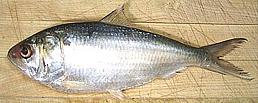 [Sardinella aurita, Round Sardninella (fishbase) |
Sardinella maderensis, Madeiran Sardinella (fishbase)]
[Sardinella aurita, Round Sardninella (fishbase) |
Sardinella maderensis, Madeiran Sardinella (fishbase)]
Spanish Sardine is supposed to be S. aurita, but the photo
specimen, sold as such, looks more like S. maderensis to me.
aurita lives all along both Atlantic coasts, the Caribbean and
the Mediterranean in both tropical and temperate zones.
Maderensis is an East Atlantic and Mediterranean fish. While
both species can grow to over 12 inches, the photo specimen was
10-1/2 inches long, 3 inches high, 1-1/4 inches thick and weighing
7-1/2 ounces. These fish are doing reasonably well and do not have
an at-risk rating, though the Madeiran may be over-fished.
Details and Cooking
 [South American Pilchard, Sardinops sagax]
[South American Pilchard, Sardinops sagax]
California is fortunate in having a good supply of these sardines sold
fresh, but they are also found along both Pacific coasts, in the
Indian Ocean and on the Atlantic side of South Africa. The photo
specimens are about 7 inches long and weigh about 2 ounces each.
Details and Cooking.
 [Sprattus sprattus]
[Sprattus sprattus]
This fish is not technically a Sardine, thought closely related. European
Sprats, canned in the same style as Sardines, are called "Brisling
Sardines" to differentiate them from the heavily smoked canned fish
widely known as "Sprats".
The Sprat genus
now has it's own page.
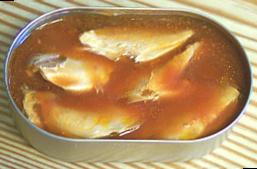 There are many varieties of Sardine, all members of the
Herring Family, and each variety is
likely to be known by a number of local names. Larger fish may be sold
fresh but many millions are canned every year, packed in water, oil,
mustard sauce and tomato sauce, with and without hot chilis.
There are many varieties of Sardine, all members of the
Herring Family, and each variety is
likely to be known by a number of local names. Larger fish may be sold
fresh but many millions are canned every year, packed in water, oil,
mustard sauce and tomato sauce, with and without hot chilis.
Morocco is the largest producer of canned sardines in the world, providing 41% of the world's exports. Personally, I find Moroccan sardines often harsh, and prefer those canned just about anywhere else. Though the flavor is not always bad, Moroccan sardines are often still covered with scales and can range from crumbly to mushy.
I have had excellent canned sardines from Portugal, Spain, Canada, Poland and Southeast Asia. Those I use most are from Poland. The two brands common around here are Bumblebee and SeaCliff. I prefer Bumblebee as SeaCliff are a little too mild for my taste.
Norway was once a major exporter of very fine sardines, but the major fishing and packing centers have been replaced by oil refineries since the discovery of oil and gas in the North Sea. Details and Cooking.
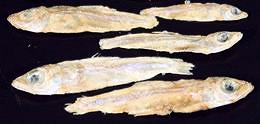 [Kapenta, Matembia (Zambia, Malawi and Zimbabwe) Limnothrissa miodon
(Lake Tanganyika Sardine) Stolothrissa tanganicae (Lake Tanganyika
Sprat)]
[Kapenta, Matembia (Zambia, Malawi and Zimbabwe) Limnothrissa miodon
(Lake Tanganyika Sardine) Stolothrissa tanganicae (Lake Tanganyika
Sprat)]
These two closely related fish are native to Lake Tanganyika and Lake Malawi.
The Sardine can grow to 6 inches (15 cm), but is usually around 3-1/2 inches
(9 cm). The Sprat is smaller, growing to 4 inches (10 cm), but commonly 2-3/4
inches (7 cm). They are both freshwater sardines, and are of considerable
nutritional value to people in the region. For details see our
Kapenta page.
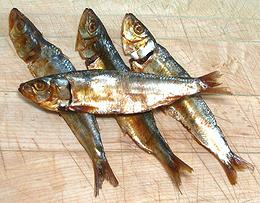 [Tuyo; genus Sardinella]
[Tuyo; genus Sardinella]
Many small and tiny fish are salted and dried in the Philippines and
are generally called Daing, but sardines are important enough
to have their own name, Tuyo. It is often simply fried whole
until almost crisp and served with a vinegar dip. Accompanied with
rice it is a very popular breakfast. For details see our
Daing, Tuyo page.